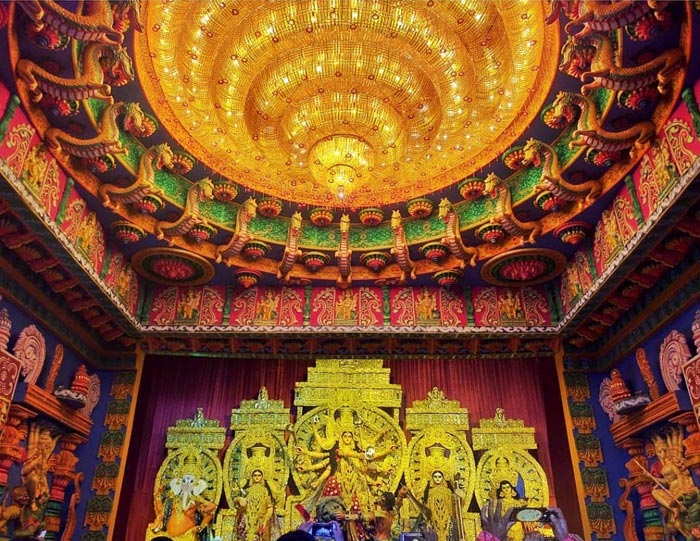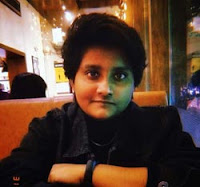Kolkata is often referred to as the cultural capital of India, situated in Eastern India lopsided Hoogly river. With the great rich traditions, colonial architecture and beautiful music and art, this city has a very unique character. As a home to brilliant artists like Satyajit Ray and Rabindranath Tagore amd many others, the people of this city have a special appreciation for Art, music, literature and cinema. This city also provides an unparalleled religious and cultural experience of Durga Puja each year.
Birth of Maa Durga
The legends speak of Goddess Durga as a creation of the three most powerful Gods in the Hindu Mythology - Brahma (the creator), Vishnu (the preserver) and Shiva (the destroyer). The story of Durga’s birth is narrated in the Devi Bhagvatam. According to this sacred text, once a son called Mahishasura was born to an Asura (demon). Born as an Asura, he saw the defeat of Asuras in every fight. Angered by the constant defeat of the Asuras, Mahishasura decided to perform a tapasaya (a long penance) to please the Devas. Years went by. Impressed by Mahishasura’s dedication, Lord Brahma granted him a boon. Delighted at such an opportunity, Mahishasura asked Brahma to bless him with so much power that neither a man nor a God could kill him. Thus, his death would lie only in the hands of a woman - which he thought was impossible. Taking advantage of the boon, Mahishasura, along with his troop of Asuras, invaded the Earth. He looted and killed with impunity.
Soon, he decided to take over heaven believing he could rule all the three realms. The battle between the Asuras and the Devas was ferocious. Mahishasura finally defeated the army of Indra in Amravati. Humiliated, the Devas met with theTridevas, hoping to find a solution. Exasperated at the defeat of the Devas, the Tridevas started to think. “Only a woman can kill Mahishasura” said Lord Brahma, thinking about the boon he had given the Asura. But no woman in the three realms was strong enough to take on the battle with Mahishasura. So, Tridevas put their minds together and using their powers created an energy which took the form of Devi Durga. Each of the Devas gave their weapon to the Devi to help her kill Mahishasura. Himavat, the God of Himalaya, gave the Devi a Lion to mount on. After this Devi Durga approached Amravati, Mahishasura laughed at the sight of a woman. But as the war proceeded, he realized that he underestimated the power of Devi Durga, and he is no match in front of her. In the ten days of fighting Mahishasura kept changing his form but Devi Durga never missed her aim.
As soon as Mahishasura changed to his original form, the Buffalo, Devi Durga beheaded him and spared the three realms from his torture. Hence Devi Durga is known as Mahishasura Mardini (The killer of Mahishasura)
Lord Rama’s ‘Akal-Bodhon’
Durga Puja is one of the biggest festivals in India, specially in West Bengal. It is traditionally held for 10 days in the month of September or October. Durga Puja celebrates the victory of the goddess Durga over the demon king Mahishasura. Apart from being a religious festival, it is also an occasion for reunion and rejuvenation, and a celebration of traditional culture and customs. While the rituals entail ten days of fast, feast and worship, the last four days, Saptami, Ashtami, Navami and Dashami - are celebrated with much merriment and grandeur in Kolkata and other countries of India as well, where the ten-armed goddess riding the lion is worshipped with great passion and devotion. Durga Puja is celebrated every year in the month of Ashwin, which is the seventh month of Hindu calendar, and commemorates Prince Rama's invocation of the goddess before going to war with the demon king Ravana. This ritual was different from the conventional Durga Puja, which is generally celebrated in the springtime. So, this Puja is also known as 'akal-bodhan' or out-of-season ('akal') worship ('bodhan'). Lord Rama was the first to worship the 'Mahishasura Mardini' or the slayer of the buffalo-demon, by offering 108 blue lotuses and lighting 108 lamps, at this time of the year. The day Lord Rama defeated Ravana is celebrated as Dussehra, which falls on the tenth day of (Dashami) Durga Puja.
Origin
The first grand worship of Goddess Durga in recorded history is said to have been celebrated in the late 1500s. The landlords, or zamindar, of Dinajpur and Malda initiated the first Durga Puja in Bengal. It is said that Raja Kangshanarayan of Taherpur or Bhabananda Mazumdar of Nadiya organized the first Sharadiya or Autumn Durga Puja in Bengal. The origin of the community puja can be credited to the twelve friends of Guptipara in Hoogly, West Bengal, who collaborated and collected contributions from local residents to conduct the first community puja called the 'baro-yaari' puja, or the 'twelve-pal' puja. The baro-yaari puja was brought to Kolkata in 1832 by Raja Harinath of Cossimbazar, who performed the Durga Puja at his ancestral home in Murshidabad from 1824 to 1831.
Celebration of the festival
In the months preceding the festival, small artisanal workshops sculpt images of Durga and her family using unfired clay pulled from the Ganga River. The worship of the goddess then begins on the inaugural day of Mahalaya, when eyes are painted onto the clay images to bring the goddess to life. Before proceeding to the Pandal, Devi Durga is decorated in saree and intricate Jewellery and garlands. When Devi Durga comes home, she doesn’t come alone. She is believed to come with her four children - Ganesha, Laxmi Saraswati and Kartick , who are placed beside her. Another important idol is Mahishasura,with a frightened expression as Devi Durga kills him with her weapon. Maa Durga is seen with ten hands. Each hand holds a weapon which are given by the gods to kill Mahishasura. All of these objects are worshipped during the Aarti, that takes place in the Pujo.
With energy buzzing in the air, the city of Kolkata lights up for then days of the Durga Puja. With the sound of Dhaak and Shankh along with the blissful smell of Bhog in the air, everyone celebrates these ten days with boundless energy. Mahalaya is believed to je the beginning of devi’s journey towards her maternal home. In the early morning everyone hears the Chandi paath in the radio or television all across Bengal. After this the Pandal hopping begins. From kids to adults everyone wears new dresses during the Puja. During these days, the Puja fever grips the heart of everyone in the city regardless of age, caste, class or gender. The entire state of West Bengal welcomes Goddess Durga and her children, along with the mighty demon Mahishasura, with open arms and hearts filled with incomprehensible emotions of togetherness.
On the Day of Dashami, Devi begins her journey back home. One of the most important part on this day is Sindoor khela, where married women offer Boron (farewell) with betel leaf, sweets and vermillion to the Devi. After this ritual, the married women apply Sindoor in the parting of each other’s hair and smear it in the faces. Following the Sindoor khela, Bishorjon of Devi Durga concludes the ceremony of Durga Puja.
The experience of Durga Puja cannot be expressed in words. It is a feeling that people live through. It is a celebration that people wait for, throughout the year. The essence of Durga Puja lies in the emotion of pure bliss during these ten days. Families reunite, grandparents meet their grandchildren, friends gossip and enjoy huge variety of food. All this under the innumerable Pandals spread across cities with the Devi keeping a watchful eye over us.
By-
Aritri Ghosh
Amity University Kolkata.



Comments
Post a Comment